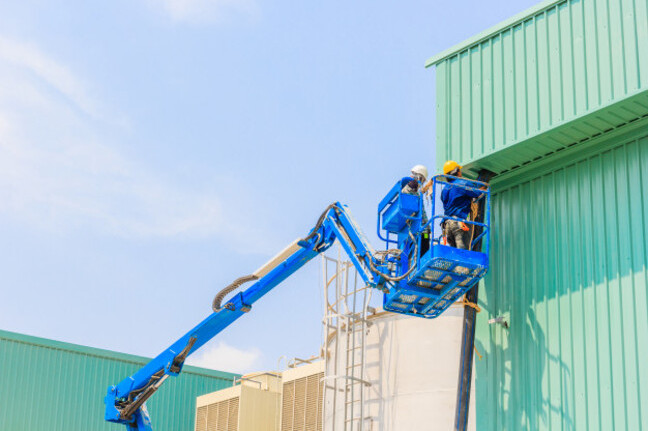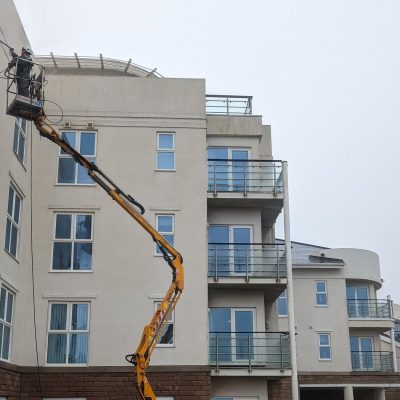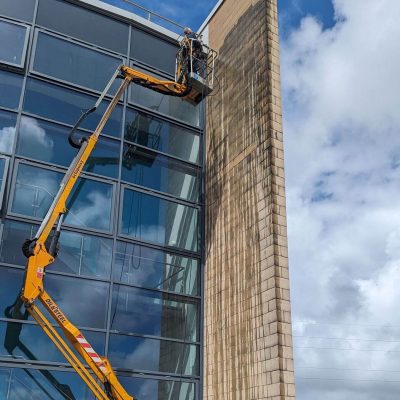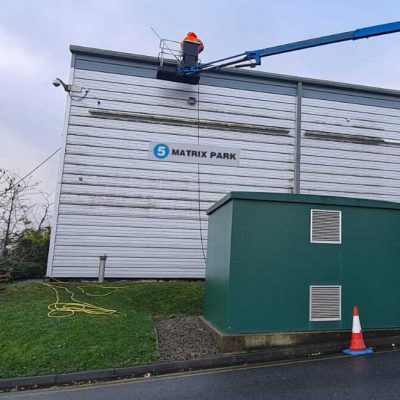If you’re undertaking a construction or renovation project that requires working at height, you’ll need to carefully consider the best equipment to keep your workers safe while enabling them to access all areas.
The two most common options are cherry pickers and scaffolding. But which one is the better choice for your specific project?
So let’s start with –
What is a Cherry Picker?
A cherry picker, also known as a boom lift or man lift, is an aerial work platform that consists of a hydraulic arm (boom) with a bucket or platform at the end for carrying workers. The arm extends upward and outward from a base unit that’s either mounted on a truck or trailer.
Cherry pickers allow one or two workers to be lifted up to heights ranging anywhere from 15 to over 100 feet. The worker stands on the platform at the end of the boom and operates the cherry picker controls to manoeuvre themselves around the job site to reach the areas needing access.
What are the Benefits of Using a Cherry Picker?
| Feature | Advantage |
| Mobility | Highly mobile since the base unit is mounted on wheels (either a truck or trailer). They can be driven around the work site and positioned exactly wherever access is needed. |
| Versatility | The articulating boom arm on a cherry picker allows workers to easily access hard-to-reach areas both vertically and horizontally. The bucket can be positioned directly where it’s needed. |
| Efficiency | Less time is wasted moving equipment or workers around the job site. The platform can be quickly repositioned and reached from a stationary base. |
| Compact footprint | As an aerial platform, cherry pickers take up less space than scaffolding. No space is needed around the structure for workers and materials. |
| Safety | Workers are protected by guardrails around the platform basket. Newer units also have features like boom motion control to prevent uncontrolled movements. |
| Minimal setup | Cherry pickers allow workers to start the job immediately since no assembly is required on site. Driving into position and extending the boom gets workers up and working within minutes. |

When is a Cherry Picker the Right Choice?
Cherry pickers work well for projects that meet some or all of these criteria:
| Feature | Benefit |
| Short duration access | Ideal for projects where aerial access is only needed for a short time. |
| Intermittent access | Can be brought in just when needed, avoiding the need to have scaffolding up for long periods. |
| Variable locations | Can be quickly repositioned to reach different high areas. |
| Interior/exterior use | Can be used to reach inside and outside a building through doors or windows. |
| Over obstacles | Can easily drive into position and reach up and over landscaping, fences, or other obstructions at ground level. |
| Soft/sensitive surfaces | Platform feet exert less pressure than scaffolding legs, making them ideal for use on delicate lawns or landscaping. |
| Remote locations | Self-powered and can travel over rugged terrain, making them useful for remote construction sites or locations far from access roads. |
What are the Limitations of Cherry Pickers?
Despite their benefits, cherry pickers do have some downsides to be aware of:
- Single/limited occupancy – The compact bucket size only allows 1 or 2 workers elevated at a time. Not ideal for larger crews.
- Lifting capacity – Have very limited capacity for lifting heavy materials and tools. The platform size and extension height restrict maximum loads.
- Weather conditions – High winds or storms can make cherry picker operation dangerous and may prohibit use.
- Overhead obstacles – Since they lift straight up, cherry pickers can’t avoid overhead power lines, tree branches, etc. like a scaffold can.
- Continuous access – Not efficient for projects requiring workers at height for very long periods of time every day. The constant repositioning would reduce productivity.
- Tight spaces – The base unit needs space to be positioned and stabilised, so cherry pickers may not work in cramped spaces or inside some structures.
What is Scaffolding?
Scaffolding provides a temporary platform that gives construction crews access for working at elevation. It consists of a framework of modular metal poles or tubes that are connected together.
Modular wooden or aluminium planks are then laid across the framework to create a stable surface for workers to stand on and do tasks overhead or alongside the area being accessed.
There are several types of scaffolding systems (we’ll talk about few):
- Supported scaffolding – Poles or frames are erected on the ground for access to the exterior of a building.
- Suspended scaffolding – Hanging platforms are lowered from rooftops for exterior facade access.
- Rolling scaffolding – Scaffolding is mounted on wheels for mobility around a work site.
- System scaffolding – Interconnecting components allow flexibility to erect complex structures.
What are the Benefits of Using Scaffolding?
| Benefit | Description |
| Load capacity | Supports much greater loads than a cherry picker. Multiple workers, heavy equipment, and large quantities of materials can be present. |
| Continuous access | Once erected, scaffolding remains in place to allow crews indefinite access for the duration of the project. No repositioning downtime. |
| Adjustable height | Can be built to the exact height required and adjusted as needed. Platform levels at different elevations can be incorporated. |
| Large work area | Planks can be joined together to create a very large work surface extending horizontally in all directions from the building face. |
| Overhead protection | Overhead toe boards, mesh netting, and canopy roofs are often added to prevent dropped objects. |
| Stable base | The resting posts and outriggers stabilise scaffold structures so they are unaffected by wind or vibration. |
| Compliant | Modular scaffolding can be erected to meet official safety codes and standards for the jurisdiction. |
When is Scaffolding the Right Choice?
Scaffolding tends to work better than a cherry picker for certain types of projects as:
- Long duration – For remodelling, construction, or restoration projects lasting weeks or months, permanent scaffolding avoids the hassle of bringing in/taking down a lift daily.
- Larger crews – Scaffolding allows multiple tradespeople to work simultaneously across a broad area, significantly improving productivity.
- Heavy loads – Scaffolding can safely support the weight of heavy materials, generators, compressors, tools, debris removal, and other equipment needing to go up.
- Interior use – Scaffolding is easily erected inside structures to access atriums, auditoriums, warehouses and other tall interior spaces.
- Tight spaces – The modular design allows custom configurations to fit scaffolding into cramped areas where other lifts won’t fit.
- Perimeter safety – Full scaffolding around a roof perimeter provides security against falling.
What are the Limitations of Scaffolding?
While scaffolding solves many access challenges, it isn’t perfect. Some downsides to consider include:
- Time to erect/dismantle – Significant hours are required to assemble and take down scaffolding.
- Upfront costs – Purchasing the quantities of poles, clamps, boards, etc. needed represents a major upfront investment. Rental costs add up for long term rentals.
- Immobility – Scaffolding remains fixed after initial assembly. To access a different area, new scaffolding sections must be erected.
- Limited height/reach – Standard scaffolding has practical limitations on maximum possible height, and horizontal reach from the building face is limited.
- Site prep needs – Space must be allocated for scaffolding setup, staging parts, loading, tool storage, and debris removal.
- Bottom platform access – A tower, ladder, or hoist system is usually required to access the bottom scaffolding platform level.
- Permitting – In most areas, scaffolding over a certain minimal height will require an engineered design and permit approval.
Other Considerations When Deciding Between Cherry Pickers and Scaffolding
Aside from the
- Pros,
- cons, and
- project-specific factors,
A few other considerations come into play when deciding between using a cherry picker or scaffolding for your construction access needs:
Cost Comparison
For smaller projects, the daily rental fees for a cherry picker from an equipment rental company often make it the more affordable option compared to buying or renting the significant quantity of scaffolding required to surround a building.
Regulatory Requirements
Most jurisdictions regulate scaffolding over a minimal height and will require permits, inspections, stamped engineering approval, and adherence to occupational safety standards. Cherry picker use may involve less red tape.
Insurance Considerations
Scaffolding erection creates potential liability if standards are not strictly followed. Your insurance rates could be impacted. Cherry picker rental may require negotiating additional liability coverage.
Crew Experience
For both cherry picker operation and scaffold building – require trained, qualified workers. Ensure your project team has the right experience for whichever option you choose.
Final Words
As you can see, cherry pickers and scaffolding each have advantages that make them optimal for certain types of construction and renovation projects.
By taking all these factors into account, you can determine the best solution for safely and efficiently accomplishing the work you have planned.
If you are looking to hire a cherry picker in Southport, Merseyside – then call us today!



